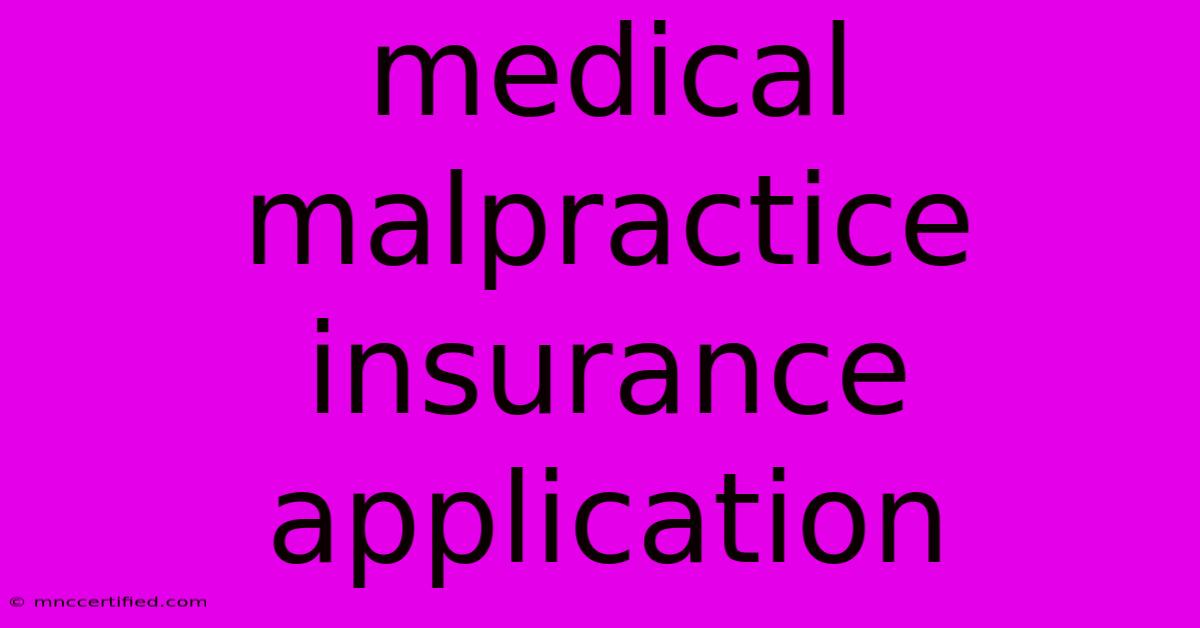Medical Malpractice Insurance Application

Table of Contents
Navigating the Maze: A Comprehensive Guide to Medical Malpractice Insurance Applications
As a healthcare professional, protecting yourself from the financial fallout of a medical malpractice lawsuit is paramount. Medical malpractice insurance serves as a vital safety net, but obtaining it requires navigating a complex application process. This comprehensive guide will equip you with the knowledge and insights necessary to successfully apply for medical malpractice insurance.
Understanding the Application Process
The application process for medical malpractice insurance varies between insurers, but generally involves the following steps:
- Initial Contact: Reach out to insurance brokers or companies directly to request an application.
- Application Submission: Complete the application form, providing detailed information about your medical practice, qualifications, and prior claims history.
- Underwriting Review: The insurer will meticulously assess your application, scrutinizing your credentials, experience, and risk profile.
- Policy Issuance (or Denial): Upon successful completion of the underwriting review, you'll receive your policy. If denied, the insurer will provide reasons for the rejection.
Key Components of the Application
A successful medical malpractice insurance application hinges on providing accurate and detailed information within these key sections:
1. Personal Information: This includes basic details like name, address, contact information, and professional licensing details.
2. Medical Practice Information: This section requires comprehensive information about your practice, including:
- Specialty: Clearly state your medical specialty and subspecialty, if applicable.
- Practice Setting: Specify whether you practice in a hospital, clinic, private office, or other setting.
- Patient Volume: Indicate the average number of patients you see annually.
- Procedures Performed: List all surgical procedures and other high-risk procedures you perform.
3. Prior Claims History: This section is crucial. Be transparent and accurate when reporting:
- Number of claims filed against you: Include all past malpractice claims, even those settled out of court.
- Dates of claims: Provide the specific dates each claim was filed.
- Outcomes of claims: Clearly state whether the claims were dismissed, settled, or resulted in a verdict against you.
4. Risk Assessment: The insurer will use various factors to assess your risk, including:
- Specialty: Some specialties, like neurosurgery, have a higher risk of malpractice claims than others.
- Experience: Years of experience and training can influence your risk profile.
- Location: The geographic location of your practice can impact claim frequency and severity.
Strategies for a Successful Application
-
Be Proactive: Initiate the application process early. Don't wait until the last minute, especially if you're nearing the end of your existing policy term.
-
Be Thorough and Accurate: Complete the application with meticulous care, ensuring all information is accurate and up-to-date.
-
Seek Professional Guidance: If you're unsure about any section of the application, consult with an insurance broker or legal professional.
-
Build a Strong Reputation: Maintaining a positive track record with patients and colleagues is crucial for minimizing your risk profile.
-
Consider Risk Management Strategies: Implement effective risk management practices in your practice, such as:
- Informed Consent: Ensure patients fully understand the risks and benefits of procedures.
- Proper Documentation: Maintain thorough medical records for every patient encounter.
- Continuing Education: Stay current with medical knowledge and best practices.
Finding the Right Coverage for Your Needs
The application process is just the first step. It's essential to shop around and compare policies from different insurers. Consider:
- Coverage Limits: Choose limits that adequately protect your assets in case of a significant claim.
- Premiums: Compare premium costs and weigh them against the level of coverage you require.
- Additional Benefits: Look for policies that offer additional benefits like legal defense coverage and claim settlement assistance.
Conclusion
Obtaining medical malpractice insurance is essential for protecting your professional and financial well-being. By understanding the application process, providing accurate information, and implementing strong risk management practices, you can increase your chances of securing the coverage you need. Remember, a proactive approach and careful planning will help you navigate the application process with confidence and secure the peace of mind that comes with adequate insurance protection.

Thank you for visiting our website wich cover about Medical Malpractice Insurance Application. We hope the information provided has been useful to you. Feel free to contact us if you have any questions or need further assistance. See you next time and dont miss to bookmark.
Featured Posts
-
Watch Club America Vs Pachuca Live Stream And Tv
Nov 07, 2024
-
Does Health Insurance Cover Dot Physicals
Nov 07, 2024
-
Nba Finals Whos Out For Warriors Celtics
Nov 07, 2024
-
Elon Musk Trumps Legacy On His Companies
Nov 07, 2024
-
Bayern Vs Benfica Starting Xi For Champions League
Nov 07, 2024